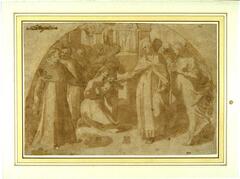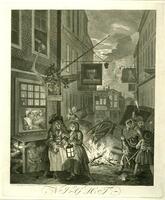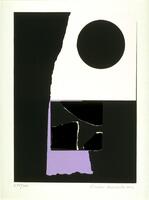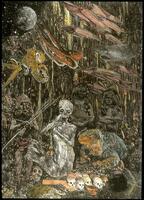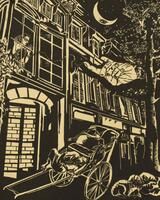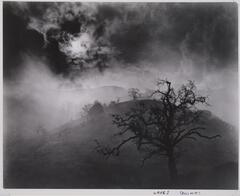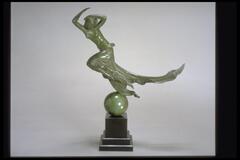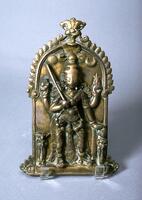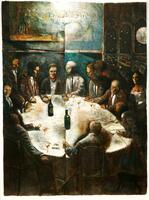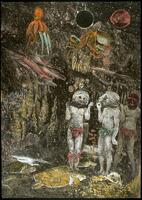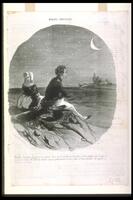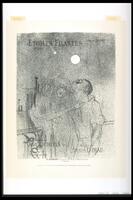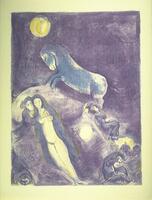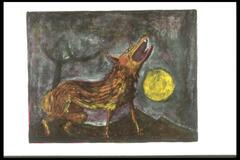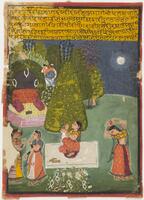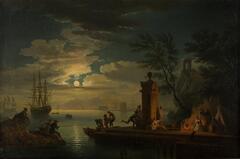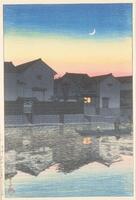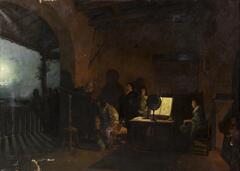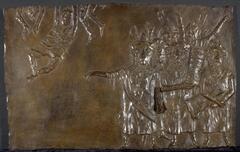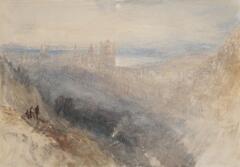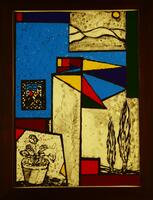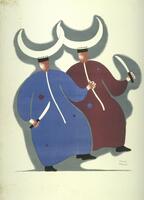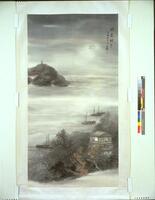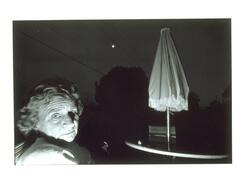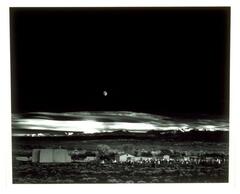3 Items in this Learning Collection
Collection Object
Collection Object
Collection Object
Copyright
All Rights Reserved
()
The Four Times of Day: Night
Accession Number
1971/2.59
Title
The Four Times of Day: Night
Artist(s)
William Hogarth
Object Creation Date
1738
Medium & Support
etching and engraving on laid paper
Dimensions
18 3/16 in x 16 in (46.2 cm x 40.64 cm);28 1/16 in x 22 1/16 in (71.28 cm x 56.04 cm);23 ⅛ in x 18 ¼ in (58.74 cm x 46.36 cm);17 7/16 in x 14 ⅜ in (44.29 cm x 36.51 cm);18 3/16 in x 16 in (46.2 cm x 40.64 cm)
Credit Line
Museum Purchase
Label copy
*Gallery Rotation Winter 2011 (January 2011)
[Hogarth intro label]
Hogarth created several series of images, such as The Rake’s Progress and Marriage à la Mode, satirizing the mores and values of eighteenth-century England. In The Four Times of Day—a series of prints made after his paintings and intended for a wider audience—Hogarth employed humor both to comment on contemporary society and to breathe new life into the genre of images that marks the progression of time by depicting the seasons, the stages of life, or the times of day.
Turning a long tradition on its head, Hogarth’s portrayals of the times of day (morning, noon, evening, and night) are situated in specific locations in contemporary London rather than an in idealized classical past. Each of the sites he chose was considered disreputable in its day and the congested settings act as foils and contexts for the figures. In this way the pastoral, eternal, and ideal images of Greek and Roman gods and goddesses so often encountered in traditional paintings in this genre become urban, specific, and comic. In addition to creating a specifically English kind of imagery, Hogarth disrupts the tradition linking the times of day with particular seasons, i.e. morning with spring, midday with summer, evening with fall, and night with winter. Instead his cycle begins with winter, which he links to morning, and ends with autumn, which he links to night.
William Hogarth
England, 1697–1764
The Four Times of Day: Night
1738
Etching and engraving
Museum purchase, 1971/2.59
This image of nocturnal mishap is set near Charring Cross—identifiable by the large statue of Charles I in the distance—a central staging post for coaches. Before the ubiquitous tavern is an inebriated Freemason identifiable as Sir Thomas de Veil, a magistrate extremely unpopular for his strict enforcing of the Gin Act. Supported by his servant, he is oblivious as waste tossed from an upper window descends on his head. Meanwhile the Salisbury Flying Coach is hardly flying. Not only has it been overturned, but the bonfire is about to ignite it and a stray firework enters the carriage window.
Gallery Rotation Winter 2011
William Hogarth
England, 1697–1764
The Four Times of Day: Night
1738
Etching and engraving
Museum purchase, 1971/2.59
This image of nocturnal mishap is set near Charring Cross—identifiable by the large statue of Charles I in the distance—a central staging post for coaches. Before the ubiquitous tavern is an inebriated Freemason identifiable as Sir Thomas de Veil, a magistrate extremely unpopular for his strict enforcing of the Gin Act. Supported by his servant, he is oblivious as waste tossed from an upper window descends on his head. Meanwhile the Salisbury Flying Coach is hardly flying. Not only has it been overturned, but the bonfire is about to ignite it and a stray firework enters the carriage window.
Subject matter
Hogarth created several print series that satirize mores and values of 18th century England. In his suite, "The Four Times of Day," executed after a series of paintings, he employed humor, not just to comment on London society but to breathe new life into images marking the times of day. Hogarth translated portrayals of the times of the day from their pastoral origins to that of contemporary London. The pastoral, eternal and ideal here become urban, specific and comic. Each of the London sites shown in this series was considered disreputable in its day and the congested setting acts as a foil and context for the figures.
An image of nocturnal mishap, "Night" is set near Charring Cross and shows, along with the ubiquitous tavern, an inebriated Freemason identified as Sir Thomas De Veil. De Veil, a magistrate known for his harsh treatment for drunkenness is supported by his servant as slops tossed from an upper window descends on the pair. More mayhem is represented by the overturned “Flying Salisbury Coach”—hardly flying as it catches fire, most likely from the torch held by the boy at the far left.
Physical Description
This print is vertically oriented with gray markings. A cream border surrounds it and it has “NIGHT” written below it. The lower half of the print has a busy street scene with lots of people taking parts of several stories (e.g. someone empting a chamber pot on people on the street, a tipped over carriage that is being set on fire, a quack doctor performing an operation in a candlelit room). The upper half of the print shows the tops of the buildings that line the street, iron-wrought shop signs, a statue of a man on horseback in the distance, and a crescent moon in a cloudy sky.
Primary Object Classification
Print
Primary Object Type
intaglio print
Additional Object Classification(s)
Print
Collection Area
Western
Rights
If you are interested in using an image for a publication, please visit http://umma.umich.edu/request-image for more information and to fill out the online Image Rights and Reproductions Request Form.
Keywords
coaches (carriages)
fires (events)
night
people (agents)
taverns
1971/2.59
Title
The Four Times of Day: Night
Artist(s)
William Hogarth
Object Creation Date
1738
Medium & Support
etching and engraving on laid paper
Dimensions
18 3/16 in x 16 in (46.2 cm x 40.64 cm);28 1/16 in x 22 1/16 in (71.28 cm x 56.04 cm);23 ⅛ in x 18 ¼ in (58.74 cm x 46.36 cm);17 7/16 in x 14 ⅜ in (44.29 cm x 36.51 cm);18 3/16 in x 16 in (46.2 cm x 40.64 cm)
Credit Line
Museum Purchase
Label copy
*Gallery Rotation Winter 2011 (January 2011)
[Hogarth intro label]
Hogarth created several series of images, such as The Rake’s Progress and Marriage à la Mode, satirizing the mores and values of eighteenth-century England. In The Four Times of Day—a series of prints made after his paintings and intended for a wider audience—Hogarth employed humor both to comment on contemporary society and to breathe new life into the genre of images that marks the progression of time by depicting the seasons, the stages of life, or the times of day.
Turning a long tradition on its head, Hogarth’s portrayals of the times of day (morning, noon, evening, and night) are situated in specific locations in contemporary London rather than an in idealized classical past. Each of the sites he chose was considered disreputable in its day and the congested settings act as foils and contexts for the figures. In this way the pastoral, eternal, and ideal images of Greek and Roman gods and goddesses so often encountered in traditional paintings in this genre become urban, specific, and comic. In addition to creating a specifically English kind of imagery, Hogarth disrupts the tradition linking the times of day with particular seasons, i.e. morning with spring, midday with summer, evening with fall, and night with winter. Instead his cycle begins with winter, which he links to morning, and ends with autumn, which he links to night.
William Hogarth
England, 1697–1764
The Four Times of Day: Night
1738
Etching and engraving
Museum purchase, 1971/2.59
This image of nocturnal mishap is set near Charring Cross—identifiable by the large statue of Charles I in the distance—a central staging post for coaches. Before the ubiquitous tavern is an inebriated Freemason identifiable as Sir Thomas de Veil, a magistrate extremely unpopular for his strict enforcing of the Gin Act. Supported by his servant, he is oblivious as waste tossed from an upper window descends on his head. Meanwhile the Salisbury Flying Coach is hardly flying. Not only has it been overturned, but the bonfire is about to ignite it and a stray firework enters the carriage window.
Gallery Rotation Winter 2011
William Hogarth
England, 1697–1764
The Four Times of Day: Night
1738
Etching and engraving
Museum purchase, 1971/2.59
This image of nocturnal mishap is set near Charring Cross—identifiable by the large statue of Charles I in the distance—a central staging post for coaches. Before the ubiquitous tavern is an inebriated Freemason identifiable as Sir Thomas de Veil, a magistrate extremely unpopular for his strict enforcing of the Gin Act. Supported by his servant, he is oblivious as waste tossed from an upper window descends on his head. Meanwhile the Salisbury Flying Coach is hardly flying. Not only has it been overturned, but the bonfire is about to ignite it and a stray firework enters the carriage window.
Subject matter
Hogarth created several print series that satirize mores and values of 18th century England. In his suite, "The Four Times of Day," executed after a series of paintings, he employed humor, not just to comment on London society but to breathe new life into images marking the times of day. Hogarth translated portrayals of the times of the day from their pastoral origins to that of contemporary London. The pastoral, eternal and ideal here become urban, specific and comic. Each of the London sites shown in this series was considered disreputable in its day and the congested setting acts as a foil and context for the figures.
An image of nocturnal mishap, "Night" is set near Charring Cross and shows, along with the ubiquitous tavern, an inebriated Freemason identified as Sir Thomas De Veil. De Veil, a magistrate known for his harsh treatment for drunkenness is supported by his servant as slops tossed from an upper window descends on the pair. More mayhem is represented by the overturned “Flying Salisbury Coach”—hardly flying as it catches fire, most likely from the torch held by the boy at the far left.
Physical Description
This print is vertically oriented with gray markings. A cream border surrounds it and it has “NIGHT” written below it. The lower half of the print has a busy street scene with lots of people taking parts of several stories (e.g. someone empting a chamber pot on people on the street, a tipped over carriage that is being set on fire, a quack doctor performing an operation in a candlelit room). The upper half of the print shows the tops of the buildings that line the street, iron-wrought shop signs, a statue of a man on horseback in the distance, and a crescent moon in a cloudy sky.
Primary Object Classification
Primary Object Type
intaglio print
Additional Object Classification(s)
Collection Area
Western
Rights
If you are interested in using an image for a publication, please visit http://umma.umich.edu/request-image for more information and to fill out the online Image Rights and Reproductions Request Form.
Keywords
coaches (carriages)
fires (events)
night
people (agents)
taverns
